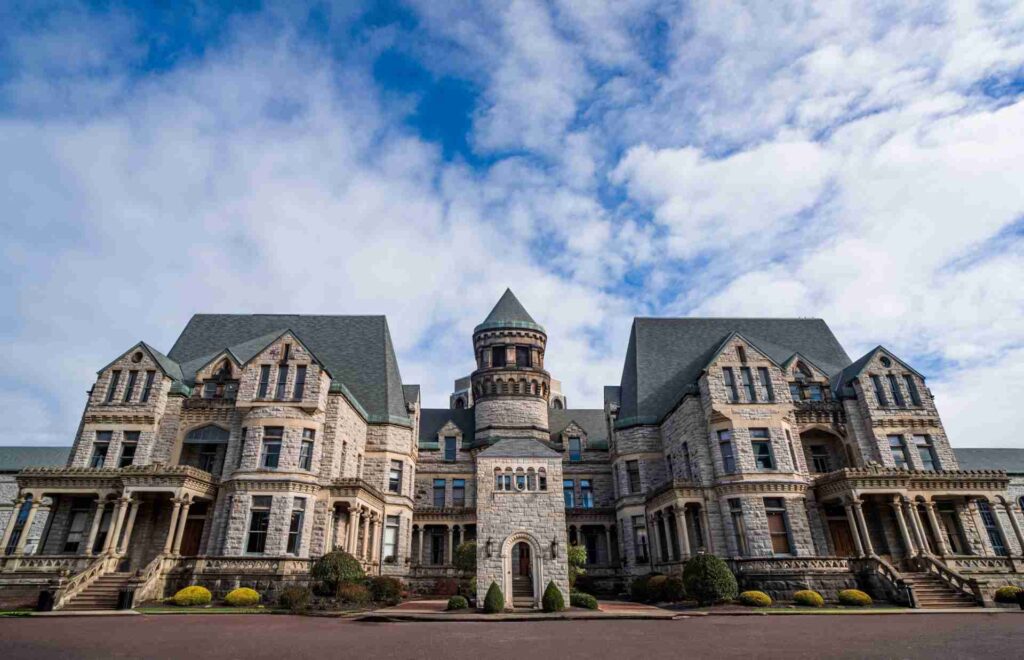Let’s face a harsh reality – prison life is supposed to be tough. Trust me, if it were easy, then all the celebrities would be doing it, like Martha Stewart, Tim Allen, Mark Wahlburg, Felicity Huffman, Robert Downey Jr., Lori Loughlin, Wesley Snipes, Sean Penn, Christian Slater, that kid who played Crabbe in the Harry Potter movies … wait … what? They’ve all been to … you’re kidding me. Even sweet dear Martha? Oh, that’s right – insider tr… um. Iron Man and Buzz Lightyear … what’d they do … oh no, nevermind. Forget I said anything.
Point is … prison life is supposed to be hard. However, how hard it’s supposed to be is debatable. The roles prisons are supposed to play in society is also often questioned. Do prisons operate to rehabilitate prisoners so they can re-enter society as productive citizens, or are they here to punish and hide away lawbreakers so the public never has to see them ever again. The answer to that question isn’t easy – it’s both … it’s neither … it’s … complicated.
Prisons have been a part of US history since the days of the American Revolution, although dungeons and other various forms of prisons have a much longer history throughout Europe. In the US, we’ve seen prisons as workhouses, in which prisoners are temporarily separated from society, punished, but also are given opportunities to learn valuable trades which they can rely upon after their incarceration ends. We’ve seen maximum security prisons where every aspect of the prisoner’s life is calculated, manipulated, and controlled.
There have been a number of notorious prisons whose names have gone down (usually with some controversy) in history, like Attica and Sing Sing in New York, San Quentin and Alcatraz in California, for just a few examples out of many. Even though all these “worst prisons in history” lists are subjective (and quite often politically charged) one name that pops up on most of these lists is right here in Ohio … and in spite of everything, it’s had a rather interesting history.
The Ohio State Reformatory
To be fair, The Ohio State Reformatory is noteworthy and notorious for two completely separate reasons. The first is that it was a prison, and not a very nice one. The second we can blame on Frank Darabont. Or, maybe we can blame Tim Robbins and Morgan Freeman, but we’ll get to that whole thing later. (Ok, maybe not Morgan, since he did play God in that one film.)
The Ohio State Reformatory began its life in Mansfield, Ohio, in 1862 as Camp Mordecai Bartley, a military installation that helped train soldiers during the Civil War. Five years later (1867) it was promoted (really, that’s the word they choose?) to an Intermediate Penitentiary, because it was located halfway between the Boys Industrial School in Lancaster and the State Penitentiary in Columbus.It seemed at the time to be a good place to deal with younger, first time offenders.
The redesign work was given to Cleveland architect Levi Scofield, who got inspiration from Victorian Gothic, Richardsonian Romanesque and Queen Anne architecture. Finally, on On September 15, 1896, The Ohio State Reformatory first opened its doors, housing 150 prisoners which were quickly put to use building walls and working on the sewer system.
Between 1935 and 1959, the facility was run by a man named Arthur Lewis Glattke who, strangely, everybody seemed to like. While being described as a tough warden, he also listened to inmate complaints and, when appropriate, made some reforms (such as music being piped into the cells).
Not everyone was thrilled by these “improvements” saying things like how prisoners are supposed to be punished while they reflect upon all the bad choices they’ve made in life, not spend their days listening to the radio.
Even back in Glattke’s days, life for inmates was pretty bad, even when compared to other prisons. From abusive guards to filthy living conditions, from barely edible food to overcrowding – the prison’s problems were fairly typical, they just seemed a lot more severe. Glattke wasn’t a heartless man, however … the same could not be said for his successors.
And with every passing year, things just got worse.
By the 1970s, the Ohio State Reformatory’s reputation was among the worst, and every day it seemed to get even worse. Prisoner rebellions and escape attempts were common, prisoners were not getting proper medical attention, guards were openly corrupt, gangs were running most aspects of daily life, and the place was so overcrowded many prisoners were left without any hope of anything.
People were starting to notice. And by the time that enough people started to try and do something about it – it was already too late. The only thing that could be done would be to close the place. But, before that could happen, another facility had to be built. So, closing the place got delayed a bit until the new facility (literally right across the street) could be finished.
In December, 1990, the last inmate would finally be transferred out and the facility would close for good. Well, almost.
Prisons As Entertainment (And Making Money)
Maybe not everyone knows this, but The Ohio State Reformatory was used in a Hollywood Blockbuster movie. Of course, I am referring to 1975’s Harry and Walter Go To New York. All in all, the movie was not quite a success. Half the critics liked it, half hated it … and my theory is the rest of the world just wasn’t ready for it yet. The movie was part historical film, part buddy-comedy, and none of those movies from around that time did very well at the box office.
Today, people say the jokes are predictable, it tries to be cute and action oriented at the same time, and a waste of the actor’s talents. Still, the film features Carol Kane, Leslie Ann Warren, Diane Keaton, Elliot Gould, Michael Caine, and James Caan, so maybe it might be worth seeing today.
At some point in the movie (no spoiler alert needed, I think) the movie takes place in a prison. I won’t tell you what happened, but all those scenes were filmed at The Ohio State Reformatory and … well, all the extras playing inmates weren’t exactly acting. (Real prisoners were used in the filming of this movie.)
Many years later, as the prison is trying to close and relocate inmates, the whole process is rife with financial woes and once again they came up with a way for the state to make a few extra bucks (and, who knows, maybe improve the inmate morale, at least a little.) Yes, they decided to film yet another movie at the Ohio State Reformatory.
But, like the earlier film shot there, this one was kind of a dud, too. (Why they tried to film a sequel in 2019 is clearly beyond me.)
Tango & Cash turned out to be one of those movies that many people say is so bad it’s kind of good… so maybe it’s worth seeing for that reason alone. It’s also worth noting that real inmates were used as extras, just like the earlier movie.
It wasn’t long after Tango & Cash was released that the history of The Ohio State Reformatory tried (but, again, failed) to come to an end. Once the last inmate was gone, as was all the equipment and files and everything that needed to be relocated was, the building sat empty for a while. The plan was to demolish the entire building, but that cost money the State didn’t feel comfortable paying right away, so the demolition date was pushed back a few times. Finally, as the demo date was almost here … something would happen that would, yet again, set that date back even farther.
In the early 1990s, there had been a number of movies based on Stephen King’s books that had been made. A few (Misery, for example) were a huge success, but the rest left a lot to be desired (Sleepwalkers, Cat’s Eye, Maximum Overdrive, The Running Man, The Lawnmower Man, and do I need to keep going?) Well, since Hollywood seems to like putting out crappy movie after crappy movie based on books by popular writers, someone decided to do it again.
One of the problems the filmmakers were facing was finding a decent filming location. They visited tons of places and none even came close to what they had envisioned for their fictional prison. But, then one day they heard about the Ohio State Reformatory, which was days away from being demolished, so a small group of producers had a “what the heck” moment and drove to Ohio to check it out.
To everyone’s dismay … The Ohio State Reformatory was absolutely perfect. They had found their prison.
I don’t think that anyone at that time would realize just how successful The Shawshank Redemption would be, nor how many Academy Awards, SAG awards, and Golden Globes it would be nominated for and today people are somewhat surprised to realize it didn’t actually win any of them. (Still, it remains the most nominated Stephen King film to date.)
After filming had wrapped up, officials began to think about demolishing things yet again, and like before that cost time and money the state wasn’t willing to pay today, if it could be put off till tomorrow.
In the future, the Reformatory would also be featured in additional movies, such as Air Force One and Escape Plan: The Extractors.
The Ohio State Reformatory Goes Bump In The Night
Following the success of The Shawshank Redemption, public interest in The Ohio State Reformatory started to grow. Suddenly, people wanted to take tours of Shawshank Prison …er, The Ohio State Reformatory and as there was money to be made by this, they made it happen.
During these tours, people wanted to know more than just movie trivia – they asked questions about the architecture, its history, and its successes and failures. The prison had so many stories, tales of torture and corruption, accounts of death by someone’s own hand or by accident or by design or murder, stories of insanity and crimes … Before long, the place got noticed by another group of people: ghost hunters and legend trippers and it wasn’t long before someone observed that The Ohio State Reformatory was one of the most haunted places in Ohio.
Today, you can learn about numerous nameless ghosts or spirits, phantom shadows that lurk down the hall, and lots of places where all forms of paranormal stuff goes on. Some of the more infamous ghosts or phenomena include things like:
- In one particular cell block, one resident who was housed there set himself on fire after dousing himself with kerosene. He seems to like making himself known during tours.
- While going up or down one particular set of stairs, people feel as if they are being pushed along, or they report seeing shadow figured in front of or behind them.
- In the graveyard, people say things move around on their own.
- In the chapel, people say they feel a presence (other than The Lord) and some say they felt phantom hands touching their shoulders.
- Helen Glattke, wife of Arthur Lewis Glattke has been spotted in the Administration areas. While her husband was warden, she accidentally shot herself with a service revolver, dying of pneumonia several days later.
- One room hoods a vengeful spirit. A chair rests in that room and if someone moves the chair, the ghost will get upset and move it back.
Depending on who you ask, there are all sorts of ghosts that roam throughout the property. And, with a history like its own, it’s not terribly hard to figure out why.



Ohio State Reformatory Today
Today, the reformatory is almost as active as it ever was, ghosts or no ghosts. Various restoration projects are still underway, and you can still take tours that cover everything from its real history, Shawshank, and ghostly appearances. And the Reformatory Museum is also worth checking out!
In August, 2024, to help commiserate the 30th anniversary of The Shawshank Redemption, a big celebration is planned … and it sounds like fun.
Other yearly events include the INKcarceration Music & Tattoo Festival – a three day Music and Tattoo Festival (no, really), a Halloween Haunted House,The Shawshank Hustle – a marathon that goes past several key locations from the film, and a paranormal and psychic convention.



